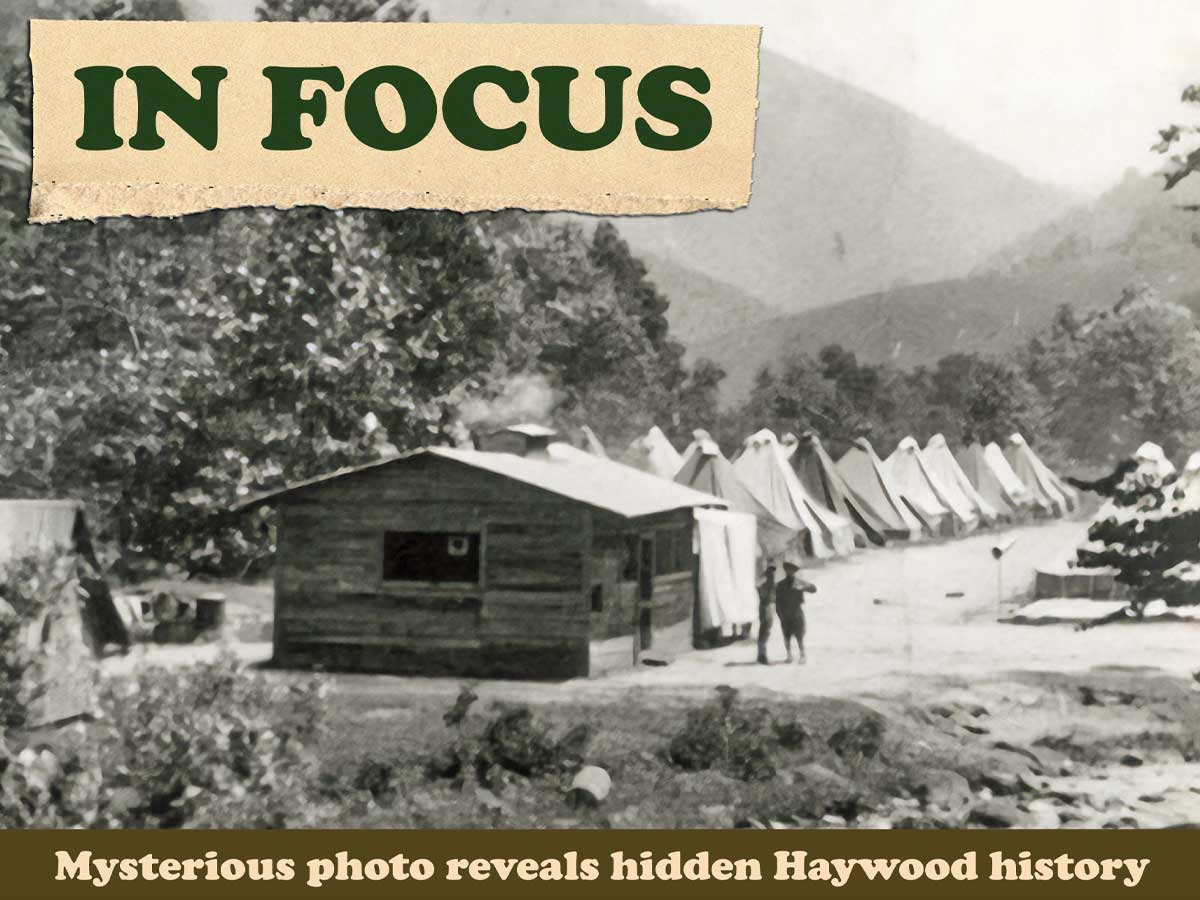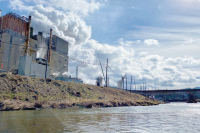An illuminating panorama of Three Forks

A few months after a devastating Pigeon River flood in 2021, some friends of the Canton Area Historical Museum gathered at the flood-ravaged building to study a couple of photographs that had been donated to the museum. One of these was obviously an early panoramic view of Haywood County’s Sunburst logging village that once thrived where the waters of Lake Logan are impounded. However, the other photo required a bit more thought and analysis to finally conclude whence it was taken.
Measuring 29.5 inches wide by 6 inches tall, this panoramic photo offers a wide sweeping vista with mountains in the background, an expansive tent encampment on one end, railroad infrastructure in the center, and a village of some sort on the opposite end. We, friends of the museum, quickly worked out that it was not another photo of the Sunburst logging village.
A junction of three mountain streams, railroad tracks running everywhere, and the small village with a notable building and belfry were clues that soon helped bring things into better focus. We concluded it had to be the region known as Three Forks in the late nineteenth century—where the Left Hand Prong, Middle Prong, and Right Hand Prong tributaries join to form the West Fork of the Pigeon River. Today, this same Three Forks area is home to Pisgah National Forest’s Sunburst Campground.
One hundred years ago, the modern Sunburst camping site hosted a junction of iron railroad tracks fanning out into the virgin forests brimming with timber treasures. The panoramic imagery we were so fortunate to find presents an intriguing glimpse into yesteryear, providing much insight into the logging infrastructure that once existed at Three Forks.
And that is not all. Those who read on will be presented with many other revelations this amazing photograph offers and will surely learn what in the world that old “tent encampment” was all about.

Related Items
- U.S. Army Tent Encampment in 1918. Courtesy of the Canton Area Historical Museum
Original Sunburst—or Spruce
As can be seen on the right-hand side of the Three Forks panoramic photo, there is significant evidence of a settlement on the banks of the Middle Prong and Right Hand Prong of the Pigeon River. Peter Thomson, founder of the Champion Fibre Company, built this little village in late 1905 and 1906 to supply pulpwood to his new pulp mill in Canton. It is reputed that Thomson named the village “Sunburst” for the way the morning sun burst over the eastern ridges.
However, other sources credit the name to Eli Potter, who designed several of the large buildings in the village, including a two-story schoolhouse/church with a wonderful belfry. Apparently, the gables of one or more of Potter’s structures were sculpted in a striking fashion that resembled a bright sunrise, thus inspiring the name “Sunburst.”
The Champion Fibre Company was never able to take advantage of its Sunburst logging village and 40,000 acres of timberlands surrounding the Pigeon River headwaters. Several factors including a “banker’s panic,” poor roads, and inadequate funds to complete the construction of a railroad to Sunburst drove Champion Fibre to take a drastic measure.
In 1911, the Champion Fibre Company agreed to exchange ownership of the Pigeon River Railway and its graded but “un-ironed” railroad, the 40,000 acres of timberlands, and the Three Forks logging village known as “Sunburst” for the guarantee of a pulpwood supply. They reached this agreement with William Whitmer & Sons, who controlled the Champion Lumber Company, owner of several vast boundaries of virgin timber in Western North Carolina and a huge band sawmill at Crestmont, located in northern Haywood County.
Champion Lumber Company completed construction of the railroad from Canton to Sunburst and a new double-band sawmill at Penland by 1913. Penland, named for the family who had owned the land for generations, was located some 3 miles below Sunburst on the West Fork of the Pigeon River. Interestingly, within a year’s time, the new sawmill village at Penland became known as “Sunburst.”
The original Sunburst village at Three Forks was tagged with the name “Spruce.” Former Champion Fibre Company employees and others still residing at the original Sunburst failed to appreciate the new name. Evidence of their disgust was reflected in the moniker they used when referring to the new Sunburst. They called it “Bastard Sunburst.”
Although imperceptible to most eyes examining the panoramic photograph, the former logging village was on its last legs at the time the photo was made. The impressive schoolhouse/church building had served as the venue for Dr. Carl Schenck’s Biltmore Forestry School from 1910 through 1913. At the end of the last school year, the Biltmore Forestry School closed its doors when Dr. Schenck returned to Germany to fulfill his military obligations.
Less than a year later, in early 1914, a fire burned down much of the village that had remained at Spruce. Started by sparks from a steam locomotive, it destroyed two boarding houses, a large commissary store, three residential houses and the office of the Champion Lumber Company.
Newspaper reports a few months after the fire announced that only “six more days remain for the people of Spruce to vacate their homes, and it is expected the Champion Lumber Company will have that town completely erased from the map within a month.” Concern for the people living in Spruce was downplayed with an assurance those uprooted workmen and their families “will be furnished homes at Sunburst.”
- This is an early panoramic photo of Three Forks, where the Left Hand, Middle, and Right Hand Prong tributaries join to form the West Fork of the Pigeon River. Courtesy of the Canton Area Historical Museum
As will be disclosed later, this panoramic photo was taken a few years after the 1914 fire. Readers will note that several houses remained occupied—with laundry drying on outside clotheslines—and Eli Potter’s two-story schoolho- use/church building is still standing. It appears that the village of Spruce had, at the time, survived the fire and the threatened “erasure” by the Champion Lumber Company.
Railroads
The Pigeon River Railway Company’s entire railroad infrastructure linking Canton and Spruce — either constructed or to be constructed — was leased to the Tennessee and North Carolina Railroad Company (T&NCRR) in 1913. Robert F. Whitmer, who was the president of both these railroad companies at the time, signed the 30-year indenture in two places — as the lessor and the lessee.
By accounts available today, it appears the T&NCRR was fully functional in 1914, providing both daily freight and passenger service between Canton, Sunburst, and Spruce (the original Sunburst.) In the center of the panoramic photo several railroad tracks, loaded and unloaded rail cars, logging equipment, the T&NCRR’s Spruce depot, storage sheds and employee houses can be made out in the precise location of today’s Sunburst Campground.
This junction of three rivers and railroad tracks was a hive of activity during those early logging days. The T&NCRR’s main line followed the West Fork of the Pigeon River from the Sunburst logging village (3 miles downstream and beyond the left side of the photo) to Spruce’s depot shown in this zoom photo. From there the Champion Lumber Company’s rails reached into the vast timber forests of the Pigeon River headwaters.
As can be seen, one set of Champion Lumber’s logging tracks makes a gentle curve across the mouth of the Middle Prong stream and heads up a gap in the mountains, hugging the Left Hand Prong as it climbs forever toward Beech Gap. Another logging railroad branches from the main line and gradually bends around a low grassy hill into the village of Spruce. From there the railroad splits, with one set of tracks running up the Right Hand Prong and the other following the Middle Prong.

- The railroad infrastructure shown in this zoom view is located at the juncture of the Left Hand, Middle, and Right Hand Prong streams. The depot and junction of railroad tracks are on the site of today’s Sunburst Campground. Courtesy of the Canton Area Historical Museum
Today, there is little remaining evidence of the village of Spruce. The entire site where houses and the schoolhouse/church building are pictured has been shrouded by the Pisgah National Forest’s heavy wilderness growth. Nevertheless, the old railroad grades leading up the Right Hand Prong and Middle Prong streams offer today’s adventurers wonderful opportunities to access the beautiful forests where they can trout fish, hike, explore and experience nature’s beauty at its best.
Before moving on, while attention has been directed to that low grassy hill behind the railroad infrastructure where the Sunburst Campground is situated today, there is something else that might interest readers. At the time the photo was taken, the hill was obviously used as pastureland, whereas, today, it is covered with a dense stand of timber.
On this hilltop, in the foreground of the photo, readers will note some sort of ground disturbance with exposed soil and several small wooden-fence enclosures. This scene just happens to be located at the same spot where an old cemetery is hidden away today, along with gravestones dating back to this same period.
The forest has very effectively obscured the cemetery over the past century, yet determined sleuths can still discover the old gravestones that remain in the area depicted in the photograph. It is possible the photo has preserved an early view of some fresh gravesites linked to the influenza epidemic raging around the country at the time the photo was made. The small wooden fence enclosures were likely constructed to protect the graves from the grazing livestock that kept the hillsides so clean.
The Tent Encampment
Tucked close to the left border of the panoramic photograph, between the railroad tracks of the T&NCRR and the West Fork of the Pigeon River, an encampment of approximately 40 canvas tents can barely be discerned. With little doubt, this camp can be associated with the United States Army’s venture to Spruce during World War I.
In early May of 1918, a local newspaper printed the following report to give Haywood County citizens a heads-up about what was occurring at Spruce or Three Forks.
“Five cars loaded with about 200 army engineers arrived at Canton…and were carried to Sunburst [actually Spruce], where they will extend the T&NCRR railroad a few miles into the forests so the Champion Lumber Co. can secure quickly quantities of balsam and spruce timber which is needed by the government to be used in making aeroplanes,” the article reads.
The United States had, at this time, joined the allied forces in Europe who were at war with Germany. Aerial warfare, which was relatively new at the time, was proving to be invaluable in this conflict, and the United States could not build airplanes fast enough to support the war effort. As the news report states, the spruce and balsam timber growing at the highest elevations of Western North Carolina’s mountains were critical materials needed to quickly construct more airplanes.
We know that World War I ended in late 1918, so it is believed the army troops’ mission to build logging railroads at Three Forks lasted only a few months. In consideration of that fact along with the obvious abundance of leaves on the deciduous trees and wildflowers pictured in the lower right corner, this wonderful and informative panoramic photograph was probably taken in the summer of 1918.
At the same time the U.S. Army was encamped at Three Forks, the Champion Lumber Company, which had declared bankruptcy and was forced into receivership two years earlier, sold its Sunburst property to the Suncrest Lumber Company. Suncrest would operate the Sunburst sawmill and log the 40,000 acres of timberland until a vast forest fire swept through the high country of the Pigeon River headwaters in 1925. More than 25,000 acres of precious timber and miles of railroads snaking through the high forests were destroyed by the inferno.
It was a catastrophe the Suncrest Lumber Company could not overcome, and all logging and sawmill operations at Sunburst were shut down. In 1928, Champion Fibre purchased the 125-acre Sunburst tract where the logging village had been located. In the early 1930s, the paper company impounded the waters of the West Fork at Sunburst, forming today’s beautiful Lake Logan which still serves as a reservoir for the Canton paper mill. Suncrest Lumber’s 40,000 acres of mountain timberlands at the Pigeon River headwaters were also sold, and this property eventually became national forest land.
Carroll C. Jones was born and raised in the papermill town of Canton, located in the heart of Western North Carolina’s mountains. He is descended from the Hargrove, Cathey, Shook, Moore and Crymes families who pioneered Haywood County. His latest book is titled “Thomson’s Pulp Mill: Building the Champion Fibre Company at Canton, N.C.—1905 to 1908.” For those interested in learning more about the old railroad that once joined Canton with Sunburst and Spruce, one of Jones’ latest articles titled “The Pigeon River’s Pea Vine Railroad” offers an important history of that winding iron road.
More about Carrol C. Jones
The author has spent a considerable amount of time in the Three Forks area over the years. Whatever the sport or diversion, whether it be flyfishing the upper reaches of the Middle Prong, hiking up the Right Hand Prong to Double Springs Gap, searching for and finding the sites of logging camps and an old funicular railroad, tracing miles of historical railroad grades and discovering century-old artifacts, locating the site of Dr. Carl Schenck’s home, and much more, this region has been a source of considerable enjoyment and learning through the years.
“Imagine my feelings when presented with this old panoramic photograph of the Three Forks area,” Jones said. “Suddenly, uncertainties such as how the railroads were laid out, the location of the T&NCRR depot, and whether Champion Lumber Company actually erased Spruce from the map in 1914 were clarified simply by studying the photo.”
Not only that, but the old photo offered a few surprises, as well. It reminds readers of the U.S. Army’s mission at Three Forks during World War I and actually revealed the exact location of their tent encampment. And for those who have trekked up the steep forested hill behind the Sunburst Campground in search of the old cemetery, we could not have been more surprised to see the image of fenced graves on top of that grassy knoll.
“It is my hope that the wonderful panoramic photograph of Three Forks will be an inspiration for everyone,” Jones said. “Let us guard and use this valuable peep back in time to ensure future generations will understand how Three Forks looked in 1918 and the role this area played in consequential industrial, cultural and even military matters. And for our children and our children’s children, please let us preserve forever the amazing native speckle trout fishing waters in the upper reaches of the Middle Prong of the Pigeon River.”










